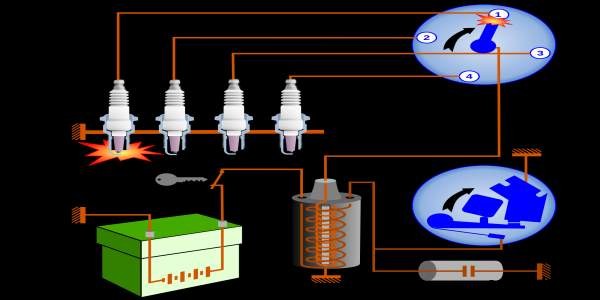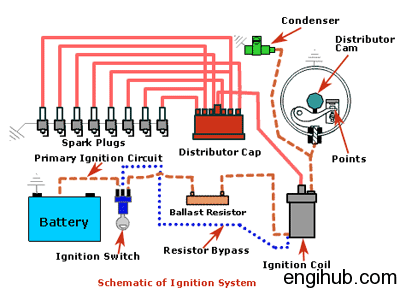There are various types of ignition systems are available to ignite the fuel in an internal combustion engine. You can use any type of ignition system to produce a spark.
In automobile engineering, the air-fuel mixture in a petrol engine starts burning by a spark plug.
Here in this post, I am going to share the most popular ignition systems with you.
With this information, you can select the proper ignition systems for your engine.

So, here are the Different Ignition Systems Used In petrol Engine
Coil Ignition Systems
These ignition systems consist of a 6 or 12-volt battery, resistance, ignition switch, and ammeter.
It also consists high tension coil, contact breaker, condenser, high tension distributor, and spark plug.
The high tension coil consists of a waterproof casing containing a few turns of heavy wire forming a primary winding.
It is surrounded by about 20000 turns of fine wire forming a secondary winding.
Both windings are wound over a laminated soft iron core and insulated from each other.
One end of the secondary winding is earthed. While the other end is connected through a heavily insulated wire into the center of the distributor cap.
A carbon contact carries the current to the rotor arm.
This is made of bronze which revolves and distributes the current to the various cylinders through spark plug leads.

Schematic Diagram of Ignition Systems
Thus the rotor arm connects the proper spark plug to the secondary winding at the required moment.
As the flow of current through the primary winding is stopped by the contact breaker.
A very high voltage (near about 8000 to 10000 volts) is induced in the secondary winding.
This voltage is supplied by the high tension distributor to the appropriate spark plug gap thereby producing a spark.
The high tension distributor and the contact breaker are placed in one body.
The condenser in the primary circuit prevents sparking at the contact breaker points.
It also increases the electromotive force in the secondary at the break.
While it further decreases the electromotive force in the secondary at make thus giving a high voltage unidirectional current.
The contact breaker consists of a cam with a number of lobes on it.
A fixed post holds one contact while other contacts are mounted on a movable arm.
The material used for contacts is platinum and tungsten.
The contact breaker points are opened only 3 to 3.5 millimeters apart.
The high tension distributor is preventing the serious trouble that is likely to be developed in the high tension coil either when the current flows due to a faulty circuit or when the ignition switch is left in the “On” position, in either case, the high tension coil may be heated up giving an inferior performance.
The resistance wire may also act as a fuse breaking the primary circuit thereby avoiding the discharge of the battery.
Magneto Ignition Systems
This system consists of a switch, a magneto, contact breaker, condenser, high tension distributor, and spark plugs.
The magneto consists of a fixed armature having a primary and secondary winding.
It has also a rotating magnetic assembly driven by the engine.
The electromotive force induced in the secondary is insufficient to produce a spark.
Consequently, it is transformed into a high voltage by the contact breaker in the primary circuit.
The voltage induced may be more than 10000 volts.
The spark is produced at the correct moment in the proper cylinder with the help of high tension distributor. (As per the action takes place in coil ignition systems.)



